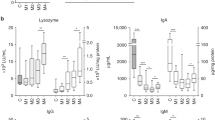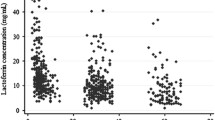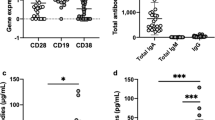Abstract
Objective:
Pasteurized, donated milk is increasingly provided to preterm infants in the absence of mother's own milk. The aim of this study was to determine the effect of pasteurization on the concentration of selected components in donated human breast milk.
Study Design:
Donated milk from 34 mothers was pooled into 17 distinct batches (4 mothers per batch). Aliquots of each batch were then Holder pasteurized (62.5 °C for 30 min). Interferon-γ (IFN-γ), tumor necrosis factor-α (TNF-α), interleukin-1β (IL-1β), IL-2, IL-4, IL-5, IL-8, IL-10, IL-12p70 and IL-13 were measured in a multiplex enzyme-linked immunosorbent assay (ELISA). Granulocyte colony-stimulating factor (G-CSF), heparin-binding epidermal-like growth factor (HB-EGF) and hepatocyte growth factor (HGF) were measured by ELISA. Lipids were assessed by gas chromatography and gangliosides by the resorcinol-HCl reaction.
Result:
IFN-γ, TNF-α, IL-1β, IL-10 and HGF were significantly reduced by pasteurization (P<0.05). Gangliosides were not affected, but the proportion of medium-chain saturated fats was increased (P<0.05) with a trend towards a decreased proportion of oleic acid (P=0.057).
Conclusion:
Pasteurization significantly reduced the concentration of several immunoactive compounds present in breast milk, but did not have an impact on others.



Similar content being viewed by others
References
Kleinman RE . Breastfeeding. Pediatric Nutrition Handbook. 6th edn. American Academy of Pediatrics: Elk Grove Village, Illinois, 2004. pp. 55–86.
HMBANA. Milk Banking Guidelines. 2009 30-10-2010. Ref Type: Online Source. http://www.hmbana.org. Accessed 9 February 2011.
Bjorksten B, Burman LG, De CP, Fredrikzon B, Gothefors L, Hernell O . Collecting and banking human milk: to heat or not to heat? Br Med J 1980; 281: 765–769.
Lawrence RA . Storage of human milk and the influence of procedures on immunological components of human milk. Acta Paediatr Suppl 1999; 88: 14–18.
Liebhaber M, Lewiston NJ, Asquith MT, Olds-Arroyo L, Sunshine P . Alterations of lymphocytes and of antibody content of human milk after processing. J Pediatr 1977; 91: 897–900.
Ford JE, Law BA, Marshall VM, Reiter B . Influence of the heat treatment of human milk on some of its protective constituents. J Pediatr 1977; 90: 29–35.
Czank C, Prime D, Hartmann B, Simmer K, Hartmann PE . Retention of the immunological proteins of pasteurized human milk in relation to pasteurizer design and practice. Pediatr Res 2009; 66: 374–379.
Evans TJ, Ryley HC, Neale LM, Dodge JA, Lewarne VM . Effect of storage and heat on antimicrobial proteins in human milk. Arch Dis Child 1978; 53: 239–241.
Koenig A, de Albuquerque Diniz EM, Barbosa SF, Vaz FA . Immunologic factors in human milk: the effects of gestational age and pasteurization. J Hum Lact 2005; 21: 439–443.
Untalan PB, Keeney SE, Palkowetz KH, Rivera A, Goldman AS . Heat susceptibility of interleukin-10 and other cytokines in donor human milk. Breastfeed Med 2009; 4: 137–144.
Goelz R, Hihn E, Hamprecht K, Dietz K, Jahn G, Poets C et al. Effects of different CMV-heat-inactivation-methods on growth factors in human breast milk. Pediatr Res 2009; 65: 458–461.
McPherson RJ, Wagner CL . The effect of pasteurization on transforming growth factor alpha and transforming growth factor beta 2 concentrations in human milk. Adv Exp Med Biol 2001; 501: 559–566.
Bertino E, Coppa GV, Giuliani F, Coscia A, Gabrielli O, Sabatino G et al. Effects of Holder pasteurization on human milk oligosaccharides. Int J Immunopathol Pharmacol 2008; 21: 381–385.
Silvestre D, Ruiz P, Martinez-Costa C, Plaza A, Lopez MC . Effect of pasteurization on the bactericidal capacity of human milk. J Hum Lact 2008; 24: 371–376.
Feng J, El-Assal ON, Besner GE . Heparin-binding epidermal growth factor-like growth factor decreases the incidence of necrotizing enterocolitis in neonatal rats. J Pediatr Surg 2006; 41: 144–149.
Feng J, El-Assal ON, Besner GE . Heparin-binding epidermal growth factor-like growth factor reduces intestinal apoptosis in neonatal rats with necrotizing enterocolitis. J Pediatr Surg 2006; 41: 742–747.
Feng J, Besner GE . Heparin-binding epidermal growth factor-like growth factor promotes enterocyte migration and proliferation in neonatal rats with necrotizing enterocolitis. J Pediatr Surg 2007; 42: 214–220.
Calhoun DA, Lunoe M, Du Y, Christensen RD . Granulocyte colony-stimulating factor is present in human milk and its receptor is present in human fetal intestine. Pediatrics 2000; 105: e7.
Schibler KR, Liechty KW, White WL, Christensen RD . Production of granulocyte colony-stimulating factor in vitro by monocytes from preterm and term neonates. Blood 1993; 82: 2478–2484.
Canpolat FE, Yurdakok M, Korkmaz A, Yigit S, Tekinalp G . Enteral granulocyte colony-stimulating factor for the treatment of mild (stage I) necrotizing enterocolitis: a placebo-controlled pilot study. J Pediatr Surg 2006; 41: 1134–1138.
Srivastava MD, Lippes J, Srivastava BI . Hepatocyte growth factor in human milk and reproductive tract fluids. Am J Reprod Immunol 1999; 42: 347–354.
Caplan MS, Jilling T . The role of polyunsaturated fatty acid supplementation in intestinal inflammation and neonatal necrotizing enterocolitis. Lipids 2001; 36: 1053–1057.
Schnabl KL, Larsen B, Van Aerde JE, Lees G, Evans M, Belosevic M et al. Gangliosides protect bowel in an infant model of necrotizing enterocolitis by suppressing proinflammatory signals. J Pediatr Gastroenterol Nutr 2009; 49 (4): 382–392.
Folch J, Lees M, Sloane Stanley GH . A simple method for the isolation and purification of total lipids from animal tissues. J Biol Chem 1957; 226: 497–509.
Morrison WR, Smith LM . Preparation of fatty acid methyl esters and dimethylacetals from lipids with boron fluoride-methanol. J Lipid Res 1964; 5: 600–608.
Cruz-Hernandez C, Kramer JK, Kennelly JJ, Glimm DR, Sorensen BM, Okine EK et al. Evaluating the conjugated linoleic acid and trans 18:1 isomers in milk fat of dairy cows fed increasing amounts of sunflower oil and a constant level of fish oil. J Dairy Sci 2007; 90: 3786–3801.
Williams MA, McCluer RH . The use of Sep-Pak C18 cartridges during the isolation of gangliosides. J Neurochem 1980; 35: 266–269.
Svennerholm L . Quantitative estimation of sialic acids. II. A colorimetric resorcinol-hydrochloric acid method. Biochim Biophys Acta 1957; 24: 604–611.
Schanler RJ, Lau C, Hurst NM, Smith EO . Randomized trial of donor human milk versus preterm formula as substitutes for mothers' own milk in the feeding of extremely premature infants. Pediatrics 2005; 116: 400–406.
Quigley MA, Henderson G, Anthony MY, McGuire W . Formula milk versus donor breast milk for feeding preterm or low birth weight infants. Cochrane Database Syst Rev 2007; CD002971.
Sullivan S, Schanler RJ, Kim JH, Patel AL, Trawoger R, Kiechl-Kohlendorfer U et al. An exclusively human milk-based diet is associated with a lower rate of necrotizing enterocolitis than a diet of human milk and bovine milk-based products. J Pediatr 2009; 156 (4): 562–567.
Bell EF . Preventing necrotizing enterocolitis: what works and how safe? Pediatrics 2005; 115: 173–174.
Omarsdottir S, Casper C, Akerman A, Polberger S, Vanpee M . Breastmilk handling routines for preterm infants in Sweden: a national cross-sectional study. Breastfeed Med 2008; 3: 165–170.
Grovslien AH, Gronn M . Donor milk banking and breastfeeding in Norway. J Hum Lact 2009; 25: 206–210.
Heiman H, Schanler RJ . Benefits of maternal and donor human milk for premature infants. Early Hum Dev 2006; 82: 781–787.
Nair RR, Warner BB, Warner BW . Role of epidermal growth factor and other growth factors in the prevention of necrotizing enterocolitis. Semin Perinatol 2008; 32: 107–113.
Kuenzler KA, Pearson PY, Schwartz MZ . Hepatocyte growth factor pretreatment reduces apoptosis and mucosal damage after intestinal ischemia-reperfusion. J Pediatr Surg 2002; 37: 1093–1097.
Lu J, Jilling T, Li D, Caplan MS . Polyunsaturated fatty acid supplementation alters proinflammatory gene expression and reduces the incidence of necrotizing enterocolitis in a neonatal rat model. Pediatr Res 2007; 61: 427–432.
Fidler N, Sauerwald TU, Demmelmair H, Koletzko B . Fat content and fatty acid composition of fresh, pasteurized, or sterilized human milk. Adv Exp Med Biol 2001; 501: 485–495.
Acknowledgements
The authors are grateful to Robert Polakowski and Paige Sorochan for technical assistance with ganglioside and fatty acid analysis, respectively.
Author information
Authors and Affiliations
Corresponding author
Ethics declarations
Competing interests
The authors declare no conflict of interest.
Rights and permissions
About this article
Cite this article
Ewaschuk, J., Unger, S., O'Connor, D. et al. Effect of pasteurization on selected immune components of donated human breast milk. J Perinatol 31, 593–598 (2011). https://doi.org/10.1038/jp.2010.209
Received:
Revised:
Accepted:
Published:
Issue Date:
DOI: https://doi.org/10.1038/jp.2010.209
- Springer Nature America, Inc.
Keywords
This article is cited by
-
Exclusive human milk diet reduces incidence of severe intraventricular hemorrhage in extremely low birth weight infants
Journal of Perinatology (2021)
-
Donated human milk use and subsequent feeding pattern in neonatal units
International Breastfeeding Journal (2019)
-
Adiponectin, leptin and insulin in breast milk: associations with maternal characteristics and infant body composition in the first year of life
International Journal of Obesity (2018)
-
Advances in paediatrics in 2016: current practices and challenges in allergy, autoimmune diseases, cardiology, endocrinology, gastroenterology, infectious diseases, neonatology, nephrology, neurology, nutrition, pulmonology
Italian Journal of Pediatrics (2017)
-
Effects of Holder pasteurization on the protein profile of human milk
Italian Journal of Pediatrics (2016)




